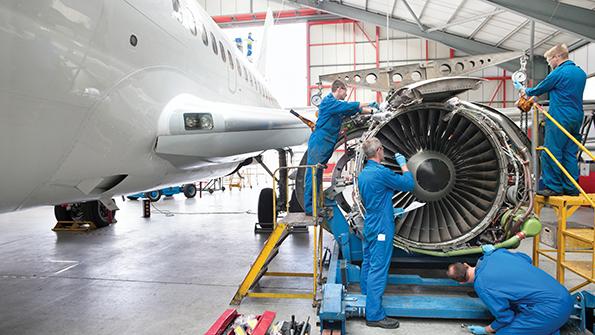MRO Workforce Crisis Looms As Aviation Begins Pandemic Recovery

Nearly every aviation maintenance, repair and overhaul (MRO) organization has been scrambling over the past few years to find enough skilled technicians to fill its workforce pipeline. Aviation maintenance technician (AMT) jobs are getting harder to fill, and the MRO industry has seen the writing on the wall as industry outlooks consistently stress the need to bring more new talent into the fold.
“Everyone in aviation maintenance needs talented labor,” says Kent Stauffer, vice president of quality, safety and training at Constant Aviation, an MRO provider that recently launched a new workforce pipeline partnership in the U.S. “The hard truth is there are not enough licensed and experienced technicians in the world today, nor are there enough AMTs coming out of Part 147 schools.”
- More than 500,000 new maintenance technicians are expected to be needed in next 20 years
- COVID-19 accelerated mechanic retirements
Boeing’s latest Pilot and Technician Outlook projects the need for 626,000 new AMTs over the next 20 years. Demand is highest in the ballooning Asia-Pacific MRO market, which Boeing says will need 249,000 technicians by 2040, followed by North America, which will need 132,000 technicians. However, the Aviation Technician Education Council (ATEC), which releases its own annual Pipeline Report, notes that only 5,205 people obtained their FAA mechanic certificate in 2020—the smallest number on record in the last two decades.
Some of this can be attributed to the COVID-19 pandemic. ATEC says 62% of the educational institutions it surveyed for its 2021 Pipeline Report noted that COVID-19 concerns and challenges negatively affected enrollment. The MRO industry also lost workers to layoffs, furloughs and early retirement.
The average age of an FAA mechanic is 53 years old, according to ATEC—11 years older than the median age for a U.S. worker—and 36% of the mechanic population is 60 or older. Many in this demographic chose to retire during the pandemic rather than ride out the uncertainty.
“We did face a lot of retirements across the system,” says Garrett West, United Airlines regional director of technical operations. “We are working right now to fill all the openings for technicians that haven’t been filled internally.”
Approximately 60-70 AMTs at United’s Chicago operations retired during the pandemic, according to West.
Younger, qualified technicians are also being lured to other industries that recognize their valuable skill sets. “Over the last 5-10 years, there has been a migration of the [airframe and powerplant] graduates being poached by other industries,” says Mike Guagenti, CEO of Launch Technical Workforce Solutions.
“Those skill sets are transferable, and there are a lot of emerging industries that are attractive to these candidates,” he adds, noting that standards for wages and career progression within MRO are limiting companies wanting to hire.
ATEC’s Pipeline Report reflects this trend, illustrating that 23% of graduates eligible for AMT employment in 2020 took jobs outside of aviation. This number is up 15% from two years ago, which ATEC attributes to the hiring freezes at many aviation employers during the height of COVID-19.
Although the pandemic affected AMT school enrollments and workforce demand temporarily, the MRO industry is now ramping back up, and many companies are finding themselves in a tight spot.
“We all know firsthand how the pandemic crushed the aviation community, not just because of sales and flights needing to be canceled . . . but because of the absolute lack of workforce that has been left over,” says Joel English, executive vice president of the Aviation Institute of Maintenance. “When the pandemic ends and we can’t get airplanes in the air because they’re not being serviced correctly, [we’ll have] a great shortage that we kind of were forced into creating ourselves.”
Guagenti points out that cargo traffic, airlines adding more capacity to fleet schedules and the maintenance procedures required for return to service are creating high demand for technicians. “What you have now is a lot of deferred maintenance that needs to be pushed through these MRO facilities,” he says. “That’s adding more pressure to the need for workers, especially as the MROs laid off a good number of their staff during the pandemic. Trying to reload talent is putting a lot of pressure on the market.”
Boeing’s report notes that technician demand is expected to “recover robustly” in the next few years as aircraft continue returning to service. “While technicians have undertaken airplane storage and engine preservation efforts over the past year, the next few years will require additional labor focused on bringing airplanes out of storage and back into service, a critical component of ensuring operational safety as the industry recovers,” says a Boeing representative.
The OEM says that meeting this demand will depend on how much the industry invests in workforce recruitment. It stresses that the global aviation community will need to focus on educational outreach, developing new aviation career pathways and adopting more efficient learning methods to meet these lofty recruitment needs.



